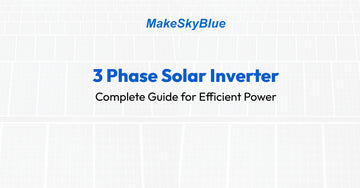One of the important components of a solar power system is a 3 phase solar inverter. It transforms direct (DC) of the solar panel into alternating (AC) current. This enables households, commercial establishments and industries to utilize clean electricity. A three-phase inverter is a more stable supply compared to a single-phase inverter in larger loads.
In today’s world, the demand for efficient solar inverters is increasing. With the growth of renewable energy, three-phase commercial inverters are used in big buildings, factories, and offices. This guide explains the working, benefits, specifications, and best models of a 3 phase solar inverter.
What is a 3-Phase Inverter?
An inverter is an instrument that transforms solar DC into usable AC. A 3-phase inverter divides power into three wires in exponential proportions. This provides a smooth operation of heavy electrical loads. It is single-phase inverters that work for small homes. Moreover, three-phase power is ideal for large houses, commercial sites, and industries. It also balances current flow, reducing voltage drop and energy loss. With a three-phase solar inverter, you can connect large solar panels and a battery storage system for continuous supply.
Key Features of 3 Phase Solar Inverter
A solar inverter is not just about conversion. It also manages safety, output, and performance. Here are the main features:
-
High Efficiency: Over 97% conversion rate.
-
Grid Support: Works with 3-phase grid-tie systems.
-
Hybrid Options: Some are 3-phase hybrid inverters with battery backup.
-
Voltage Support: Compatible with 208VAC and 480VAC.
-
Smart Monitoring: Supports Wi-Fi and app monitoring.
-
Reliability: Long warranty (10–15 years).
Difference Between Single-Phase and Three-Phase Solar Inverters
|
Feature |
Single-Phase Inverter |
3 Phase Solar Inverter |
|
Power Supply |
One wire |
Three wires |
|
Usage |
Small homes |
Large homes, commercial |
|
Load Handling |
Low |
High |
|
Efficiency |
90–95% |
97–99% |
|
Voltage Support |
120–240VAC |
208–480VAC |
|
Battery Backup |
Limited |
Advanced |
|
Best For |
Residential |
Residential & Commercial |
Advantages of Three Phase Solar Inverter
Choosing a three phase commercial inverter gives several benefits:
-
Handles large solar panel systems.
-
Provides stable electricity for factories and offices.
-
Works with backup battery systems.
-
Reduces downtime with efficient synergy technology.
-
Supports off-grid systems for remote areas.
Hybrid Inverters and Battery Systems
A 3-phase hybrid inverter is a modern solution. It supports both solar power and battery backup. This ensures power during grid failure and works with PV panels and batteries. Furthermore, it provides off-grid and on-grid options and is ideal for homes and light commercial setups. Hybrid systems are now popular in both residential and commercial solar installations.
Popular 3 Phase Solar Inverter Models
|
Brand / Model |
Capacity |
Voltage Support |
Best Use |
Special Feature |
|
Solaredge Three Phase Synergy |
80kW |
480VAC |
Commercial, Industrial |
Synergy Manager Technology |
|
Fronius Symo 3-Phase |
20kW |
208–480VAC |
Large Residential, Office |
High Efficiency |
|
Huawei SUN2000 3-Phase |
15–100kW |
208–480VAC |
Commercial Solar |
Smart Monitoring |
|
SMA Sunny Tripower |
25kW |
208–480VAC |
Residential + Commercial |
Grid-Tie Support |
|
GoodWe 3-Phase Hybrid |
10–50kW |
208–480VAC |
Residential + Backup |
Battery Storage |
Installation and Specifications
Installing a 3 phase inverter requires certified technicians. The process includes:
-
Mounting the inverter near solar panels.
-
Connecting DC cables from panels.
-
Linking AC output to the three-phase power system.
-
Adding an optional battery storage system.
-
Setting up smart monitoring tools.
Warranty and Reliability
The majority of business inverters have 10-15 year warranties. A high end product such as Solaredge three phase or Fronius inverters provides long term service as well as support. The brand you selected must be safe, reliable and performs.
Final Thoughts
The 3 phase solar inverter is always necessary in large homes, commercial buildings and industries. It provides comfort in electricity flow, backup batteries and links to solar panels to ensure use of energy efficiently. Solaredge, Fronius, Huawei, SMA, or GoodWe, are inverters that are long lasting. Investing in the correct three-phase solar inverter will help to save money, reliable power supply, and promote renewable energy objectives.
FAQs
What is a 3 phase solar inverter?
A 3 phase solar inverter transforms DC power of the solar panels into AC power on three wires. It can be used in large residential, commercial and industrial areas.
What is the difference between single-phase and three-phase inverters?
Single phase inverters deliver the power in a single wire, appropriate in small houses. Three phase inverters spread load of three wires hence it is more suitable in usage.
Can I use a 3 phase solar inverter at home?
Yes, large residential homes with high energy needs can use 3-phase inverters. They are especially useful for air conditioning, heating, and EV charging.
What brands make the best three-phase inverters?
Top brands include Solaredge, Fronius, Huawei, SMA, and GoodWe. They offer reliable commercial inverters with long warranties.
Does a 3-phase inverter work with batteries?
Yes, many 3-phase hybrid inverters support battery backup. This ensures continuous power even during grid failures.





